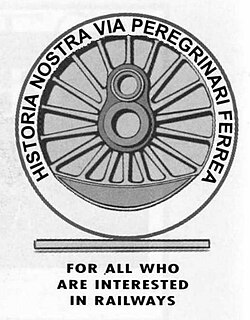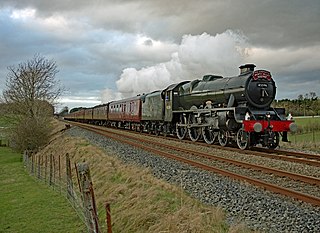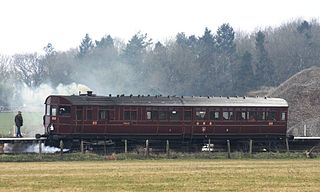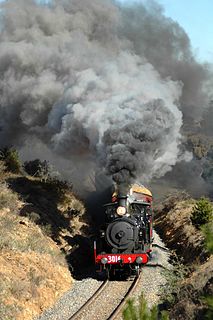Related Research Articles

LNER Class A4 4468 Mallard is a 4-6-2 ("Pacific") steam locomotive built in 1938 for operation on the London and North Eastern Railway (LNER) at Doncaster Works to a design of Nigel Gresley. Its streamlined, wind tunnel tested design allowed it to haul long distance express passenger services at high speeds. On 3 July 1938, Mallard broke the world speed record for steam locomotives at 126 mph (203 km/h), which still stands.

West Coast Railways (WCR) is a railway spot-hire company and charter train operator based at Carnforth MPD in Lancashire. Using buildings and other facilities previously owned by the Steamtown Carnforth visitor attraction, in June 1998 the company became the first privately owned company to be given a licence as a train operating company.

The Pichi Richi Railway is a 39 kilometres narrow-gauge heritage railway in the southern Flinders Ranges of South Australia between Quorn and Port Augusta. For much of its length it lies in the picturesque Pichi Richi Pass, where the line was completed in 1879 as work proceeded north to build a railway to the "Red Centre" of Australia – the Central Australia Railway. The Commonwealth Railways ran trains through the pass until 1980, when it ceased its by then meagre services.

LNER Class A3 4472 Flying Scotsman is a 4-6-2 Pacific steam locomotive built in 1923 for the London and North Eastern Railway (LNER) at Doncaster Works to a design of Nigel Gresley. It was employed on long-distance express East Coast Main Line trains by the LNER and its successors, British Railways Eastern and North-Eastern Regions, notably on the London to Edinburgh Flying Scotsman train service after which it was named.

The Great Western Railway (GWR) steam locomotive No. 4936 Kinlet Hall is a preserved 4-6-0 Hall class locomotive

The Australian Railway Historical Society (ARHS) aims to foster an interest in the railways, and record and preserve many facets of railway operations. It had divisions in every state and the Australian Capital Territory, although the Victorian division was wound up in 2020. Since 1967, when each division incorporated, the state divisions have operated as separate entities. Each still trades under the ARHS brand, except in Western Australia, where the division is called Rail Heritage WA. Individual membership exceeds 2,500.

London, Midland and Scottish Railway (LMS) Jubilee Class 5596Bahamas is a preserved British steam locomotive. It is named after The Bahamas.
The GWR was the longest-lived of the pre-nationalisation railway companies in Britain, surviving the 'Grouping' of the railways in 1923 almost unchanged. As a result, the history of its numbering and classification of locomotives is relatively complicated. This page explains the principal systems that were used.
The South Gippsland railway line is a partially closed railway line in Victoria, Australia. It was first opened in 1892, branching from the Orbost line at Dandenong, and extending to Port Albert. Much of it remained open until December 1994. Today, only the section between Dandenong and Cranbourne remains open for use. The section of the line from Nyora to Leongatha was used by the South Gippsland Tourist Railway until it ceased operations in 2016. The section from Nyora to Welshpool, with extension trail to Port Welshpool and a portion of the former line at Koo Wee Rup, have been converted into the Great Southern Rail Trail.

The Lachlan Valley Railway Society is an Australian rail preservation society based in the New South Wales Central Western town of Cowra. It was established in 1974 to preserve and operate former New South Wales Government Railways locomotives and rolling stock. It operates regular heritage train tours to a variety of locations across New South Wales.
The Railway Enthusiasts Society Incorporated is a New Zealand railway enthusiast society formed on 17 July 1958. RES formed the Glenbrook Vintage Railway (GVR) in 1968, with GVR now forming a separate charitable trust.

East Coast Heritage Rail is a not for profit company limited by guarantee formed in June 1985 as 3801 Limited to operate steam locomotive 3801 and its associated rolling stock. The company operated heritage train tours from 1986 until 2017, with operations recommencing in February 2019 under the new brand, East Coast Heritage Rail.

The steam rail motors (SRM) were self-propelled carriages operated by the Great Western Railway in England and Wales from 1903 to 1935. They incorporated a steam locomotive within the body of the carriage.

The SECR B1 class was a class of 4-4-0 steam tender locomotive for express passenger service on the South Eastern and Chatham Railway. These engines were originally designed by James Stirling for the South Eastern Railway (SER) in 1898 and designated B class. The SER was merged into the SECR in 1899 and, between 1910 and 1927 the B class engines were rebuilt with new boilers by Harry Wainwright to become B1 class.

3112 is a two-cylinder, simple, non-condensing, saturated, coal-fired ‘Baltic’ type, 4-6-4T steam C30 class locomotive built for the New South Wales Government Railways in 1914 by Beyer, Peacock and Company.

The Canberra Railway Museum is located at Kingston in the Australian Capital Territory (ACT), next to Canberra railway station on the Bombala railway line. Since May 2018, Canberra Railway Museum has been the trading name of a not-for-profit company, Capital Region Heritage Rail Limited, established to run the museum, while ACT Heritage Rail Holdings Limited is the company responsible for safeguarding the heritage assets of the museum.

Sir Haydn is a narrow gauge steam locomotive, built by Hughes's Locomotive & Tramway Engine Works of the Falcon Works, Loughborough in 1878. It operated on the Corris Railway in Wales, until closure in 1948, and since 1951 has operated on the nearby Talyllyn Railway. It has carried the operating number 3 under four successive owners.
The Queensland Pioneer Steam Railway is located near Ipswich, Queensland, Australia and runs through the former West Moreton pioneering coal fields. It was first opened in 1881 by colliery proprietor and politician Lewis Thomas (1832-1913) as a tramway to his coal mines.

Ashford Steam Centre was a short-lived railway museum at Willesborough, Ashford, Kent, United Kingdom. It was located at the former engine shed that was situated east of Ashford railway station. The museum opened in 1968 and closed in 1976.
A railfan or railway enthusiast and sometimes also called a trainspotter is a person interested, recreationally, in rail transport. Railfans of many ages can be found worldwide. To support the hobby in the United Kingdom, railway enthusiast societies or clubs were formed though many are now defunct.
References
- ↑ The Railway Observer Volume 86, Number 1054 - issued December 2016
- ↑ The Railway Observer Volume 88, Number 1078 - issued December 2018
- 1 2 Foreword by Rodney Lissenden (then Chairman of the RCTS in Vintage Railtours, Railway Correspondence and Travel Society, A pictorial record 1954-69 by Gavin Morrison, pub. 1993 ISBN 1 85794 007 5
- ↑ The Railway Observer Volumes 11-16, Numbers 130 to 185
- ↑ The Railway Observer Volume 49, Numbers 592-594
- ↑ The Railway Observer Volume 49, Numbers 591 and 595
- ↑ Specifically, for the Society's Archive and Library at Leatherhead station
- ↑ 'The Railway Observer' Volume 90, Number 1102, December 2020
- ↑ RCTS Website - 2020